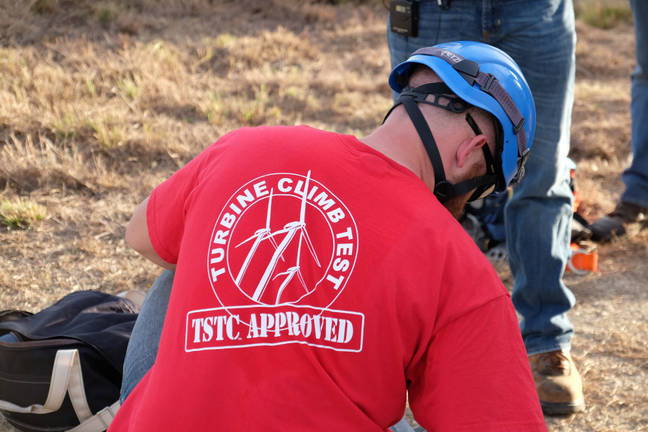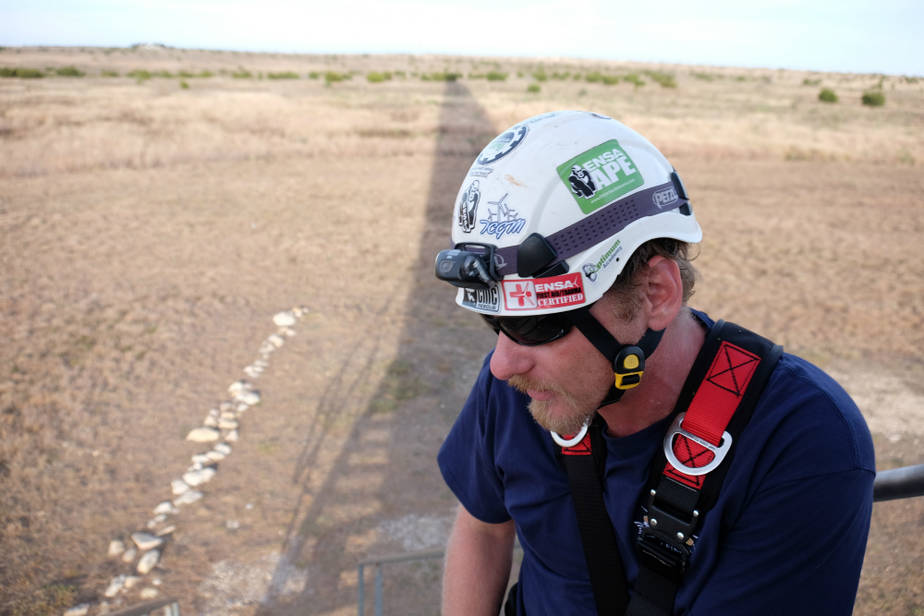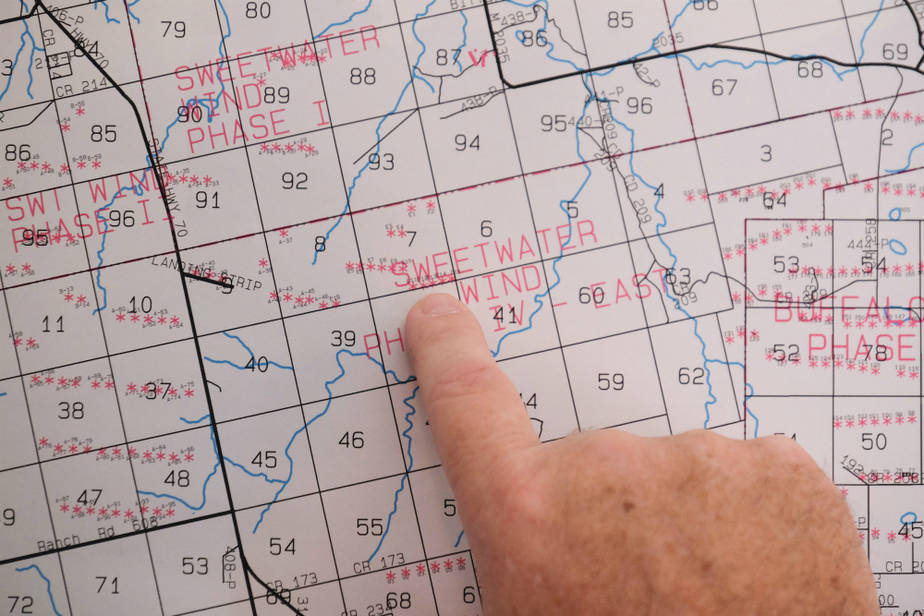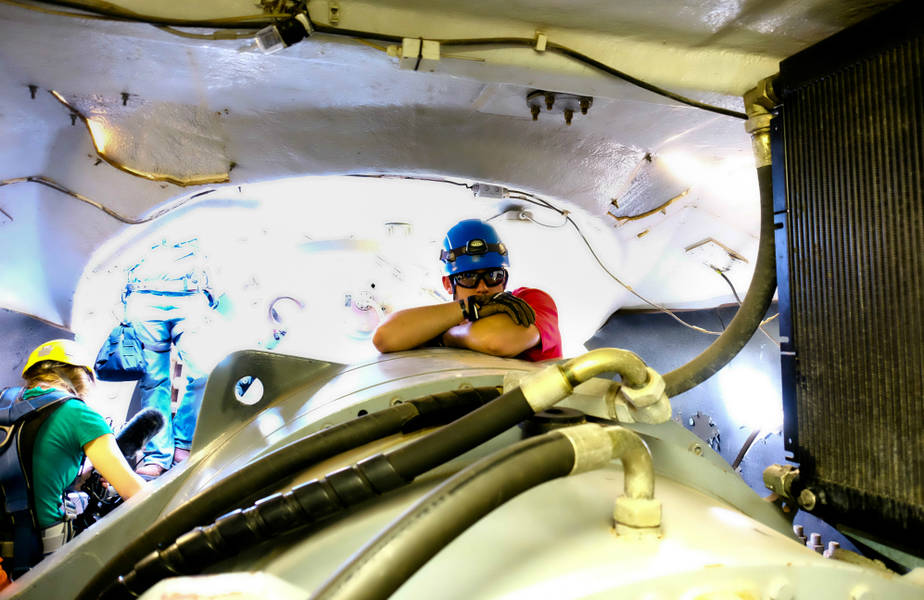Wind Farming Creating Jobs and Building New Economy in Texas

Above Photo: Wind and oil operate side-by-side in West Texas, where ranchers often rely on lease payments from wind farms to diversify their income, particularly during drought years. Credit: Meera Surbamanian
Wind turbines bring jobs, tax dollars for new schools, income security for farmers and energy independence. To these Texans, climate change has little to do with it.
All along the straight-shot roads of Nolan County in West Texas, wind turbines soar over endless acres of farms, the landscape either heavy with cotton ready to harvest or flushed green with the start of winter wheat. The turbines rise from expanses of ranches, where black Angus beef cattle gaze placidly at the horizon. Here and there are abandoned farmhouses dating to the 1880s, when this land was first settled and water windmills were first erected. Occasionally a few pump jacks bob their metallic heads, vestiges of a once-booming oil industry still satiating an endless thirst.
Every industry creates an ecosystem around it. If the wind turbines that sprouted in West Texas were huge steel trees, spinning sleek carbon-fiber blades 100 feet in length, then the wind farms—including Roscoe Wind Project and Horse Hollow Wind Energy Center, some of the largest in the world—were their forest. Spread out across the expansive vista, invisible air currents feed the structures, their imperceptible roots extending out to the community that contains them.
 “The wind industry has changed my life, and it’s changed it for the better,” James Beall told me as we stood at the base of one of those industrial versions of an old-growth tree, a 2 megawatt DeWind turbine that Texas State Technical College (TSTC) owns and uses to train its students to become wind energy technicians. While four of those students climbed 258 rungs of a vertical ladder to the nacelle, the streamlined mechanical housing at the top of the turbine, James and I awaited an elevator to take us up. From here on the ground, the nacelle, perched on its 300-foot column, looked tiny. It was actually the size of a bus.
“The wind industry has changed my life, and it’s changed it for the better,” James Beall told me as we stood at the base of one of those industrial versions of an old-growth tree, a 2 megawatt DeWind turbine that Texas State Technical College (TSTC) owns and uses to train its students to become wind energy technicians. While four of those students climbed 258 rungs of a vertical ladder to the nacelle, the streamlined mechanical housing at the top of the turbine, James and I awaited an elevator to take us up. From here on the ground, the nacelle, perched on its 300-foot column, looked tiny. It was actually the size of a bus.
As discussions around climate change in America have become partisan, so have those around kilowatts—but not here. There was money to be made, and these students—like the Texan Republicans in power over the last 20 years—weren’t going to miss out on the chance to make it.
James is 39 years old, with a strawberry blonde beard and a voice smooth from his upbringing in the Nolan County seat of Sweetwater, also home to the West Texas campus of TSTC. As we waited for the elevator, we talked about the danger of working in the oil and gas fields—an industry that his father had made him promise, when he was 18, never to work in. James’ father, a Vietnam vet, had worked in the oil fields when James was a boy, before finally getting disability pay for post-traumatic stress disorder, or PTSD, which dated back to his time in Vietnam when he’d been sent in to clean up the massacre of Hamburger Hill, James told me. But while Vietnam had broken James’s father’s mind, it was the oil fields that were the greater hazard for his body. It was there where he had broken his back and later his leg. It was the reason he had extracted the pledge from his son never to work in the industry—a tall order for a young man in Sweetwater, with few other opportunities.
 Eventually James became an electrician—until 2003, when his son was born prematurely and needed someone to stay home with him. Since his wife made more money as a waitress at the local steakhouse, serving all the wind technicians who came in, it was James who became the stay-at-home parent. When his son was in school and he was ready to go back to work, he looked out at all those turbines popping up around his home and tried to get in on the boom, but employers wouldn’t hire him because of his lack of experience. So he enrolled in the new wind technician program down the road at TSTC. Now, seven years later, he is not only a certified wind technician, but also a teacher in the program.
Eventually James became an electrician—until 2003, when his son was born prematurely and needed someone to stay home with him. Since his wife made more money as a waitress at the local steakhouse, serving all the wind technicians who came in, it was James who became the stay-at-home parent. When his son was in school and he was ready to go back to work, he looked out at all those turbines popping up around his home and tried to get in on the boom, but employers wouldn’t hire him because of his lack of experience. So he enrolled in the new wind technician program down the road at TSTC. Now, seven years later, he is not only a certified wind technician, but also a teacher in the program.
“The path I was heading down for a while” was not a savory one, James told me as the sound of the students climbing overhead reverberated around us. “I luckily escaped prison. Everybody has their vices at one point in time, and it’s up to you to change your life and do what you need to do to be the better person. Wind helped me do that.”
It was like finding Jesus. But with a steady paycheck.
The elevator arrived, and James and I squeezed inside the cramped metal mesh container. We rose as if we were water, inching our way up the interior of a great redwood tree by capillary action.
Wind’s Ascent
Wind energy development in Nolan County dates back to 2001, when the first wind farms were constructed in the area. A perfect confluence of events led to the growth of the industry since then.
There was a supportive state government, led by Republicans George W. Bush and then Rick Perry, pushing for wind by putting the regulatory and infrastructure pieces in place to make it successful. The state’s nearly autonomous electric grid meant no troublesome cross-border or federal approval was needed to get wind electricity from places like Sweetwater to the green-leaning urban markets clamoring for renewable energy. And then there were the Texans themselves, ever eager to use their land and diversify their revenue sources, especially as recurring droughts killed off the cotton and the livestock, and oil fields were either going dry or failing to pay for themselves. At the same time, federal incentives came (and went, and came again) in the form of production tax credits that helped the wind industry offset large investment costs.
Wind and oil operate side-by-side in West Texas, where ranchers often rely on lease payments from wind farms to diversify their income, particularly during drought years. Credit: Meera Surbamanian
If Texas were a nation, it would be the sixth-largest wind energy producer in the world. The bulk of that power is coming from the Nolan County region. And so the reddest parts of Texas are responsible for supplying upwards of 12 percent of the state’s energy needs every month with clean, green kilowatts. Occasionally, as happened one day in the blustery month of October this year (a time when those energy-sucking A/C units are switched off and electricity usage is low), it provided more than half of the electricity to the state’s power grid.
The Lure of Wind Industry Jobs
As the wind industry grew through the early 2000s, so did a desperate need for skilled labor. What emerged was the 2008 launch of TSTC’s Wind Energy Technology program, where James enrolled in 2010 and where he returned to teach in 2013 after working in the field for a couple of years.
According to the Bureau of Labor Statistics, wind technician is currently the second-fastest growing job in America (beat out only by solar photovoltaic installer). By the end of last year, there were more than 100,000 jobs related to the wind industry nationwide, at least one-fifth of them in Texas. When the American Wind Energy Association (AWEA) launched a seal of approval for wind technician programs in 2011, TSTC was one of only three schools in the U.S. to receive it.

Wind technicians Kaitlin Sullivan and Devan Moore are rigged with safety harnesses for working at the top of a wind turbine. Credit: Meera Subramanian
The students James teaches are a slice of the next generation of wind workers for an industry that, at least in this part of the country, has already established itself. They include veterans and women, those leaning politically right and left, environmentalists and climate change skeptics, the civically engaged and those who never vote. The clean energy component seems to be a bonus for some, but it was not the primary reason they chose this field. There is the laid-off gas worker who noticed all the wind turbines on the horizon and thought there must be an opportunity there. The English major who couldn’t find a job and remembered how much she liked the outdoor work on her family’s farm in the Texas panhandle. The two veterans who liked the element of risk and heights and the sweet spot of job independence and camaraderie.
Typical of the right-leaning students at TSTC was 31-year-old Scott Maxey. Scott had escaped his home in Redding, California, when he felt that the only job in town was working at Starbucks for minimum wage. He drove until his truck ran out of gas—which happened to be in Sweetwater. He was 25 years old, and he landed a job at one of the two big gypsum mills in town. Making sheetrock paid him more than double what he would have earned as a barista back home. But “at the gyp mill, the hazards there were just too much for my health,” he told me. “I just wasn’t doing well.”
So in 2015, he found work in oil and gas, hauling the sand needed for natural gas fracking, which was on the rise in Texas alongside wind. But there was too much market variability with gas; within a year, Scott was laid off, and the guys he worked with told him to expect that to happen regularly.
“I’m looking around, and there’s wind turbines everywhere,” he said with a dusky laugh. “It just made sense. Why don’t I work for the wind turbine industry?” Impatient to get back into the workforce, he opted for TSTC’s one-year certificate program as opposed to the two-year associate’s degree. When we spoke in November, he had one more semester left before he got his certificate, and he already had a job offer that would take him to Florida to work on solar, and then to California to work on wind.

Texas State Technical College has started wind energy training programs on two of its campuses, in Sweetwater and Harlingen. Credit: Meera Subramanian
In Scott’s mind, clean energy has nothing to do with climate change, which he said has been with us “since the beginning of time. It happens naturally. I don’t think human input is what’s making it change.”
And protecting the environment is not his motivation for getting involved in the industry. Sure, he said, it’s important to be “responsible stewards” of the earth. “There’s no reason to pollute rivers. There’s no reason to go down and just mow down environments just because we can. Totally not okay.” But he went into this field for one reason only: job security.
Scott is not alone in this—which is why the wind industry in West Texas is making for some very interesting bedfellows.
‘Politics Falls to the Wayside’
Nearly three-quarters of Nolan County voters who showed up in November 2016 voted for Donald Trump, who has been more outspoken about reviving the dying American coal industry than about supporting the flourishing wind sector. But that figure only reflects who showed up at the polls. Of the four TSTC students I spoke to at the turbine tower, all of whom were investing their future in wind, only two had voted—a 50 percent rate that reflects the national average. There are always reasons not to vote. The Army vet was overseas, another student was busy. James was busy, too.
“I’m not really political,” James said, “or when I do think about it, it’s already over. I just get so lost with everything going on here, and home life. … It’s just overwhelming. Politics falls to the wayside.”

“What was advanced yesterday is no longer advanced today,” James Beall said. He sees wind power and its continuing advancements as the future. Credit: Meera Subramanian
While I was in Texas, one year after Trump’s election, members of Congress were working on a tax bill that could affect the economics of wind energy in America. The fact that crafting the tax bill was in many ways an exercise in horse-trading behind closed doors seemed to both support and refute the reasoning of everyone who had decided to stay away from the voting booth.
But what happens in D.C. comes to roost on the tips of the turbine blades of Sweetwater. Just as the students of TSTC were seeking certainty for their futures, so too has the wind industry sought stability in the federal financial incentives that help offset initial capital costs. After years of fluctuating tax credits, a bipartisan effort by Congress in 2015 locked in a five-year Renewable Electricity Production Tax Credit (PTC) for wind development. It provided a 2.3-cent tax credit for every kilowatt of electricity produced, with a gradual decline over a five-year period. By mid-November the House version of the tax bill aimed to eliminate the credit immediately. It would have meant a complete mid-stream change in the financial game plan for wind energy companies and the financiers who back them. What American businesses, towns, and citizens want is the opposite of these oscillations; they want certainty.

Ken Becker, executive director of Sweetwater Economic Development, points to some of the 1,300 wind turbines that dot a Nolan County map. Credit: Meera Subramanian
Business interests in Sweetwater were watching these changes on Capitol Hill with some trepidation. “If it affects the industry, [even] if it doesn’t affect us today, it will affect us at some point,” said Ken Becker, executive director of the Sweetwater Economic Development Corp (SEED). We were sitting in his downtown office, on the second floor of an historic Spanish Colonial Revival style home that serves as the Chamber of Commerce, as he told me how wind energy had bolstered the local economy.
“In pre-wind, our county taxable value was $500 million,” Ken explained. “In 2008, it was $2.8 billion,” a five-fold increase that translated to new schools and grand expansions at the local hospital. That’s money for the town, but also a steady income for local landowners, some of whom earn up to $1,000 per month from having a single commercial turbine on their property—and most of the region’s world-class wind farms are dotted across private land. Many say they’re “not sure they’d even have the ranch today if the wind didn’t come on,” Ken told me.

Wind power today provides 12 percent of Texas’s electricity. Credit: Meera Subramanian
The wind construction boom has slowed—or, perhaps more accurately, morphed—as the industry enters its second generation. Sweetwater has a population of about 10,000, and back at the peak of wind development in 2008, as the economy was crumbling, it was estimated that 18 percent of the town’s working population was employed on wind projects, Ken said. Now, he acknowledged, the number of full-time jobs in wind technology is a small fraction of that, but only if you disregard the hundreds of peripheral jobs that rely on the wind energy sector.
These complementary industries are the ecosystem that wind power belongs to—and its reach is growing. Repowering, which vastly increases efficiency by either replacing old turbines for more powerful ones or upgrading components, means more megawatts with the same footprint. It also means a whole new category of jobs. While I was there, evidence of these peripheral industries was everywhere. I watched 80-foot blades swapped out for ones twice as long. (The production tax credits helped these efforts, too.) I visited Global Fiberglass Solutions of Texas, which was setting up shop in an old aluminum recycling plant to process the decommissioned blades—which were being amassed in a 10-acre field—into building panels and other materials.

The wind industry is changing and the jobs base around it is expanding as existing turbines are retrofitted with new technology. Credit: Meera Subramanian
Across the street from Global Fiberglass Solutions was the Argentinian company EMA, which builds electrical breakers specially designed for renewable power systems and employs about a hundred people.
And down the road in Roscoe, in an old mercantile brick building inscribed with “Shelansky’s Dry Goods,” beside a high curb designed for horse carriages, teens at Edu-Drone were learning skills that would earn them FAA licensing as drone pilots. They were simultaneously earning a high school diploma and an associate’s degree, aiming for a career that could have them use the flying cameras to inspect wind turbine blades for damage from hail or lightning strikes.
The Wind Will Always Blow Here
Back at the TSTC turbine, high above the mesquite below, the elevator shuddered to a stop at the top. Well, almost at the top. While James, who had a hurt shoulder, waited below, I clipped in my lanyard line and climbed up the last 40-foot stretch to get up to the nacelle.
The four students who had climbed up by ladder were already there, along with Billie Jones Hudson, another TSTC wind instructor. Billie, 42, whose long brown hair was pulled back in a tight ponytail and tucked down her shirt, had been a prison guard and an elementary school art teacher before working in wind. Together we stood amid the hydraulics, cooling systems and electrical boxes of the nacelle. It was all basic mechanics, but supersized. Big bolts, smeared with grease, attaching one massive piece of metal to the next. There was the slightest of sway to the entire structure, which one student, Kaitlin Sullivan, 25, equated to a boat.

“You just feel like you’re on top of the world,” said Johnathon McCarthy, a West Virginia Marine who served in Afghanistan before starting the TSTC program. Credit: Meera Subramanian
With one more hoist, I could look out the hatch that opened up to the sky, the blades reaching to infinity, airplane wings on end. This is what everyone I spoke to in the wind industry loves the most about this work. It is the exact opposite of descending deep into the earth to mine coal in shafts no taller than the height of a small child. There is risk to wind work—an arc flash, a long fall—but never the prospect of being trapped underground for days as there is with coal. There are no oil leaks that can’t be staunched. It felt like freedom. Energy freedom. Professional freedom. Economic freedom. Our turbine’s blades were still, but I could see dozens of others spinning along the horizon below, the wind that blew through them altered, molecules shifted.
“It’s breathless,” was how student Johnathon McCarthy, a 28-year-old West Virginian who served in Afghanistan as a Marine, described being up there. “You see other turbines around you spinning. You see the cars that are just this small. You see the people down there and they’re even smaller, like ants. You just feel like you’re on top of the world.”

According to the Bureau of Labor Statistics, wind technician is currently the second-fastest growing job in America. Credit: Meera Subramanian
The best places for wind are often the places that are struggling to keep rural communities alive.
What was happening in Nolan County proved that the debate about how we generate our kilowatts doesn’t have to be about climate change. It could be about embracing whatever clean energy options are available to help make small-town America economically viable. In this deeply red place, it was the embodiment of President Barack Obama’s all-of-the-above strategy. At the close of 2016, 86 percent of the country’s onshore wind turbines were located in Republican districts, according to the 2016 U.S. Wind Industry Annual Market Report. Indeed, Republican Sens. Rob Portman of Ohio and John Thune of South Dakota were some of the primary advocates responsible for keeping the PTC in place in the final version of the tax overhaul bill, which was signed Dec. 22.
Too soon, it was time to leave our aerie. Kaitlin sung the words to “When It Rains” in a clear soprano voice, the confined space of the nacelle a perfect sound chamber, as we all worked our way down. I climbed back to where James awaited me, and we returned to our constrained positions in the elevator.
“What was advanced yesterday is no longer advanced today,” he said as we slowly descended, “and what’s advanced today will no longer be advanced tomorrow. Same way with wind turbines; they’re always advancing.” Periodically, light slipped through into our confined space, illuminating his face.
“This is a totally different world. I believe this is the future,” he said, pausing for a moment. Then he added, almost to himself, “I hope it’s the future.”
Source Article from https://popularresistance.org/in-west-texas-where-wind-power-means-jobs-climate-talk-is-beside-the-point/
 RSS Feed
RSS Feed















 April 17th, 2018
April 17th, 2018  Awake Goy
Awake Goy  Posted in
Posted in  Tags:
Tags: 













